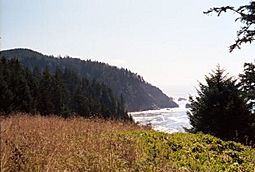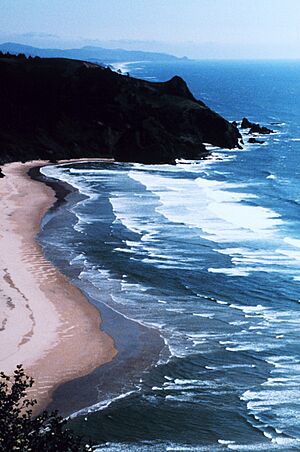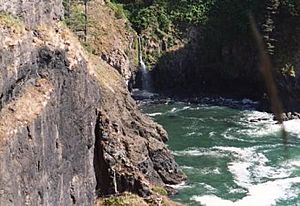Cascade Head facts for kids
Quick facts for kids Cascade Head |
|
|---|---|
|
IUCN Category V (Protected Landscape/Seascape)
|
|

Cascade Head
|
|
| Location | Tillamook County, Oregon, United States |
| Nearest city | Lincoln City |
| Area | 37,162 acres (150.39 km2) |
| Established | 1966 |
| Owner | Nature Conservancy |
Cascade Head is a special place on the Oregon Coast in the United States. It's a large headland, which is a piece of land that sticks out into the ocean. It's also a huge experimental forest, covering about 102,110 acres (41,322 hectares).
This area is part of the World Network of Biosphere Reserves. This means it's recognized by UNESCO (a part of the United Nations) as a place where people are working to protect nature and learn about it. Cascade Head is located about 85 miles (137 km) southwest of Portland, Oregon, between the towns of Lincoln City and Neskowin.
Contents
What is a Biosphere Region?
Cascade Head became a Biosphere Region in 1976. This special status means it's a place where people try to balance protecting nature with using the land in a smart way. The area was made even bigger in 2016.
Inside the Cascade Head Biosphere Region, you'll find several important areas:
- The Cascade Head Scenic Research Area
- The Cascade Head Experimental Forest
- The Cascade Head Preserve
- The Cascade Head Marine Reserve and Marine Protected Areas
This region has many different types of environments. It includes the Salmon River and its estuary (where the river meets the ocean). There's also a sandy beach area, thick coastal rainforests, and a two-mile basalt headland. This headland is covered in native coastal prairie plants. The marine reserve stretches out into the Pacific Ocean.
Protecting Cascade Head
In the early 1960s, people started working to protect Cascade Head from being built on. By 1966, they had raised enough money to buy the land. They then gave it to The Nature Conservancy, a group that works to protect important natural areas.
Because of its amazing natural importance, Cascade Head and the lands around it became a National Scenic Research Area in 1980. It also received its United Nations Biosphere Reserve status around this time.
Scientists at The Nature Conservancy are working to help the Oregon silverspot butterfly. This butterfly is very rare! They are trying different ways to keep the grassland habitat healthy for it, sometimes even using controlled fires. Ecologists also keep an eye on rare plants throughout the year. Many volunteers help out too. They remove plants that don't belong there, help keep trails clear, and teach visitors about the preserve.
A Forest for Science
The Cascade Head Experimental Forest was created in 1934. It's a place where scientists study the typical coastal forests found along the Oregon Coast. These forests are mostly made up of Sitka spruce and western hemlock trees. Scientists have been doing long-term studies and experiments here ever since.
In 1974, a special law made the Cascade Head Scenic Research Area. This area includes part of the experimental forest, several prairie headlands, and the Salmon River estuary to the south.
Scientists have done many studies at Cascade Head. They've learned about how native trees grow and how much wood they produce. They also study how plants and the climate are connected. A weather station set up in 1936 is still working today! It's an official United States Weather Bureau site.
More recently, scientists are studying how forest ecosystems work. They look at things like how wind affects the trees, how nutrients move through the soil, and how the forest helps with global carbon cycling.
Research has also been happening at the Salmon River estuary since 1979. Scientists are studying how the salt marsh ecosystems are growing back after old dikes were removed. They also study how fish like salmon use these restored areas.
Amazing Plants and Animals
Cascade Head is home to many native plants. Some of these include red fescue, wild rye, Pacific reedgrass, coastal paintbrush, goldenrod, blue violet, and streambank lupine. A very rare flower called the hairy checkermallow (Sidalcea hirtipes) is also found here.
Almost all of the world's population of the Cascade Head catchfly flower lives here! The Oregon silverspot butterfly is also very rare. It's found in only five other places in the world. This butterfly needs a specific plant, the early blue violet (Viola adunca), for its young to eat.
Many animals live in the preserve too. You might find elk, deer, coyote, cougar, black bear, snowshoe hare, and the Pacific giant salamander. Birds like osprey, bald eagle, great horned owl, northern harrier, red-tail hawk, and sometimes even a peregrine falcon can be seen flying overhead.
How Cascade Head Was Formed
Cascade Head is actually an extinct, uplifted volcano. This means it was once a volcano that was under the Pacific Ocean, but now it's no longer active and has been pushed up above the water.




